
Gompholobium ecostatum, commonly known as dwarf wedge-pea, is a species of flowering plant in the family Fabaceae and is endemic to southern Australia. It is a low-lying to erect shrub with trifoliate leaves with linear to lance-shaped leaflets, and apricot-coloured to reddish, sometimes yellow flowers.

Gompholobium huegelii, commonly known as common wedge-pea is a species of flowering plant in the family Fabaceae and is endemic to south-eastern Australia. It is an erect or spreading shrub with trifoliate leaves and cream-coloured to yellow and greenish, pea-like flowers.

Gompholobium latifolium, commonly known as golden glory pea or broad-leaved wedge-pea, is a plant in the pea family Fabaceae and is endemic to eastern Australia. It is a small shrub with leaves composed of three leaflets and which has relatively large yellow flowers in spring and early summer.

Gompholobium grandiflorum, commonly known as large wedge-pea, is a species of flowering plant in the family Fabaceae and is endemic to eastern New South Wales. It is an erect, more or less glabrous shrub with trifoliate leaves and lemon-yellow and greenish, pea-like flowers.
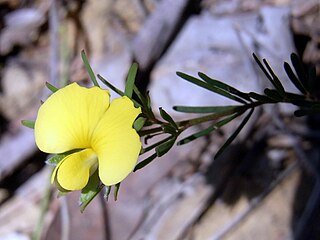
Gompholobium glabratum, commonly known as dainty wedge-pea, is a species of flowering plant in the family Fabaceae and is endemic to south-eastern continental Australia. It is a low-lying or ascending shrub with pinnate leaves that have five to seven leaflets, and yellow and green or greyish flowers.
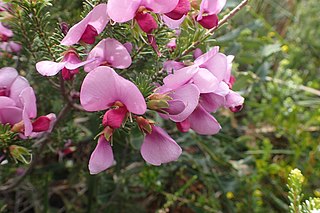
Gompholobium scabrum is a species of flowering plant in the pea family Fabaceae and is endemic to the south-west of Western Australia. It is an erect to spreading shrub with linear leaves and pink or purple flowers with some darker markings.
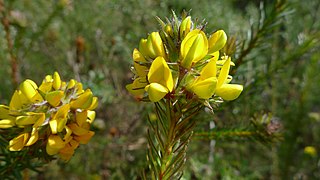
Pultenaea stipularis, commonly known as handsome bush-pea, is a species of flowering plant in the family Fabaceae and is endemic to New South Wales. It is an erect shrub with glabrous stems, linear to narrow elliptic leaves, and yellow to orange flowers, sometimes with red markings.

Bossiaea rupicola is a species of flowering plant in the family Fabaceae and is endemic to eastern Australia. It is an erect shrub or small tree with silky-hairy, narrow egg-shaped to narrow elliptic leaves and red flowers with yellow markings.
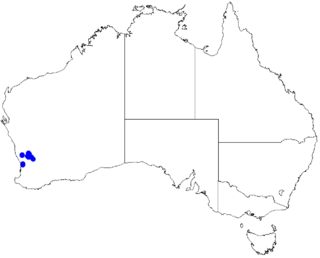
Boronia ericifolia, commonly known as Wongan Hills boronia, is a plant in the citrus family, Rutaceae and is endemic to the south-west of Western Australia. It is an erect, densely branched shrub with trifoliate leaves and pink, white or creamy yellow flowers with four petals and eight stamens only known from near Wongan Hills and Moora.

Gompholobium foliolosum is a species of flowering plant in the family Fabaceae and is endemic to eastern Australia. It is an erect shrub with pinnate leaves and orange-red, pea-like flowers.
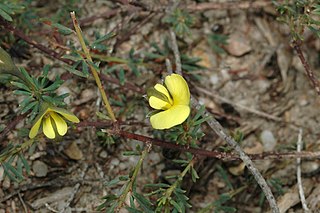
Gompholobium inconspicuum, commonly known as creeping wedge-pea is a species of flowering plant in the family Fabaceae and is endemic to south-eastern continental Australia. It is a prostrate or low-lying shrub with trifoliate leaves and pale lemon yellow to yellowish green, pea-like flowers.
Gompholobium karijini is a species of flowering plant in the family Fabaceae and is endemic to the north-west of Western Australia. It is an erect, openly-branched shrub with pinnate leaves with five to ten pairs of leaflets, and racemes of yellow to orange and creamy-yellow, pea-like flowers.
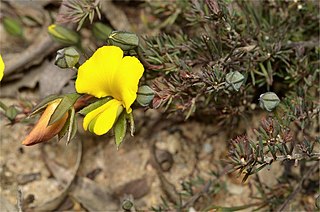
Gompholobium minus, commonly known as dwarf wedge-pea, is a species of flowering plant in the pea family Fabaceae and is endemic to New South Wales. It is a low, spreading shrub with trifoliate leaves and yellow flowers.
Gompholobium oreophilum is a species of flowering plant in the family Fabaceae and is endemic to the north-west of Western Australia. It is an erect shrub with pinnate leaves with elliptic leaflets, and racemes of yellow to orange and creamy-yellow, pea-like flowers.
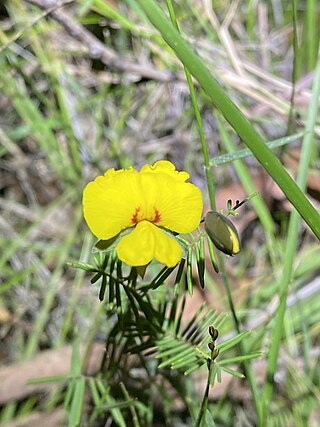
Gompholobium pinnatum, commonly known as pinnate wedge-pea, is a species of flowering plant in the pea family Fabaceae and is endemic to eastern Australia. It is an ascending or erect shrub with pinnate leaves and yellow flowers with red marks.
Gompholobium polyzygum is a species of flowering plant in the family Fabaceae and is endemic to north-western Australia. It is an erect or prostrate shrub with pinnate leaves each with sixteen to twenty-one pairs of leaflets, and yellow-orange and greenish, pea-like flowers.
Gompholobium subulatum is a species of flowering plant in the pea family Fabaceae and is endemic to northern Australia. It is a slender, erect shrub with pinnate leaves with five to eleven leaflets, and uniformly yellow, pea-like flowers.
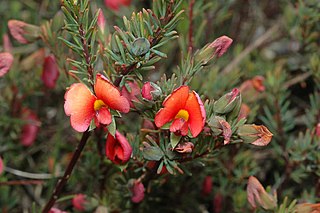
Gompholobium uncinatum, commonly known as red wedge pea, is a species of flowering plant in the family Fabaceae and is endemic to eastern Australia. It is a small, low-lying shrub with trifoliate leaves, the leaflets linear to narrow lance-shaped, and red, or orange-red and yellow-green, pea-like flowers.

Gompholobium venustum, commonly known as handsome wedge-pea, is a species of flowering plant in the family Fabaceae and is endemic to the south-west of Western Australia. It is a slender, erect or sprawling shrub with pinnate leaves with fifteen to nineteen leaflets, and yellow or pink, pea-like flowers.

Gompholobium virgatum, commonly known as leafy wedge pea, is a species of flowering plant in the family Fabaceae and is endemic to eastern Australia. It is a erect or sprawling shrub with trifoliate leaves, the leaflets narrow egg-shaped with the narrower end towards the base, and yellow and greenish, pea-like flowers.
















